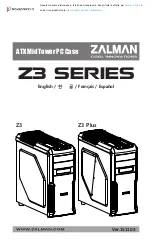
MENU ADJUSTMENTS
1. Button definition
Set/Save
Bit Select/decrease
Adjust/increase
Users can adjust the parameters.
The backlight of LCD will be off after 30s without any key’s operation.
Note: the LCD will display "----" when the settings are successful, and display "Err" when failed.
2. Operation instruction
Users can adjust transmitter parameters. Push
button to enter programming. "P000" will be displayed. Push
button to select the Column and push
button to cycle 0-9 settings. Select different Codes to enter
corresponding parameter group settings.
Page 5
Automation Components, Inc.
2305 Pleasant View Road | Middleton, WI 53562
Phone:
1-888-967-5224 |
Website:
workaci.com
Page 6
3. System Error signal
DEVICE CONFIGURATION THROUGH MODBUS RTU
MODBUS RTU INTERFACE
The Modbus Remote Terminal Unit (RTU) data link protocol uses EIA-485 as a two-wire, daisy chain
network. A branch is a discrete chain of devices connected to a controller. The max number of devices per
segment is (32), as per the Modbus specifications. 4000 ft (1219.2 m) is the maximum recommended length
for a segment, which includes all devices from the controller to the last device in the daisy chain.
Each branch must have all devices connected with (A) connected to (A) and (B) connected to (B). If a
shielded cable is used, this is not to be connected to the devices. The shield cable should only be
connected on one end to earth ground, usually at the controller.
Each device must be configured for the correct baud rate and have a unique address in each branch. The
baud rate for the branch is set by the controller.
EOL TERMINATION RESISTANCE SELECTION
RS-485 requires that the last device in a chain have a termination resistor. This is controlled using a jumper
in the center and right pins(120 Ω) position marked on FIGURE 7. When the jumper is set to 120 Ω, a 120 Ω
resistance is added in parallel to the data line. When the jumper is set to left and center pins(disabled), the
resistance is not added. By default, the jumper is placed in the disabled position.
A typical Modbus RTU mode message frame is shown below. In the Modbus RTU mode, the messages
between frames are separated by at least 3.5 characters time’s silent interval. If the silent interval between
two characters is more than 3.5 characters time, the former character was transferred successfully, and the
current character’s transmission starts.
ADDRESS SELECTION
Modbus can locate up to 256 different addresses, including valid addresses from 1-247. Address 0 is for
broadcast and address 248~255 are reserved for special addresses.
Slave address can be set with compatible Modbus RTU software or via Menu selection(see above for Menu
Adjustments). Default address is 1.
BAUD RATE, DATABITS, PARITY, AND STOPBITS SELECTION
Baud rate is set to 9600, but can also be configured to 4800 via the register or via Menu selection(see above
for Menu Adjustments).
The device that requests information is called the Modbus Master and the devices giving the information
are Modbus Slaves. The Modbus sensors are slave devices and the number of Data Bits needs to be the
same as in the Master device configuration. ACI’s Modbus RTU sensors utilize 8 data bits during
communication exchange.
Parity default setting is NONE. Stopbit default setting is 1. Both settings can adjusted via the register or via
Menu selection(see above for Menu Adjustments).
FUNCTION
The function code is the second data in the frame. Valid function codes are from 0~127 (01H~7FH). See the
relevant Modbus standard. It supports 03H/06H function codes, shown as the following Modbus Poll
software. The detail register addresses are in: 6 General registers table.
BROADCAST MODE TO WRITE DATA TO SLAVE
Using broadcast mode, customer can write data to all slaves connected to the network. Address of
broadcast mode to write data is 0.
For example: change slave address with broadcast mode, customer can set a new slave address. Note: since
this operation will modify all the addresses of the slavers to the same address, it is NOT applicable for
network of more than one slave.
Register Address
40001, 00000
40002, 00001
40003, 00002
……
40014, 00013
……
40016, 00015
40017, 00016
40018, 00017
40019, 00018
40020, 00019
40021, 00020
40022, 00021
……
40029, 00028
40030, 00029
R/W
R
R
R
R/W
R/W
R/W
R/W
R/W
R/W
R/W
R/W
R/W
R/W
Type
Signed
Signed
Signed
Signed
Signed
Signed
Signed
Signed
Signed
Signed
Signed
Signed
Signed
Definition
Product code
PM2.5 Value
PM10 Value
RS485-Modbus RTU slave address
Function register
Relay Control Mode
Back up
Set point (mode 1 or 2) low limit
(mode 3 or 4) regional
Dead band (mode 1 or 2) high
limit(mode 3 or 4)
Start delay
Stop delay
Baud rate
Parity
Remarks
PM series Product code: 9070
PM2.5 = Value , ug/m³
PM10 = Value , ug/m³
Default slave address =1, (RTU,9600,n,8,1)
Write 40016=21845 to reset to factory
default setting
0: Off
1: Relay activated Below the set point.
2: Relay activated Higher than set point.
3: Relay activated in the set range
4: Relay activated outside the set range
Relay control parameters set
Baud rate: 9600(default) or 4800
Parity : 0: NONE, 1: ODD, 2: EVEN
Note: 1. 40001 is PLC mode ADDRESS (BASE 1); 00000 is PROTOCOL ADDRESS (BASE 0).
2. Function register 40016: Use the 06 function code to write password (21845) to the register 40016 to
return to the factory set.
MODBUS RTU
SPECIAL MODE TO READ DATA FROM SLAVE
With the special mode, customer can read the register data under the circumstance of NOT knowing the
slave address.
Address of special mode read data: 255(0xFF)
Note: this operation is applicable for ONLY ONE slave in the network.
Version: 1.0
I0000941


























